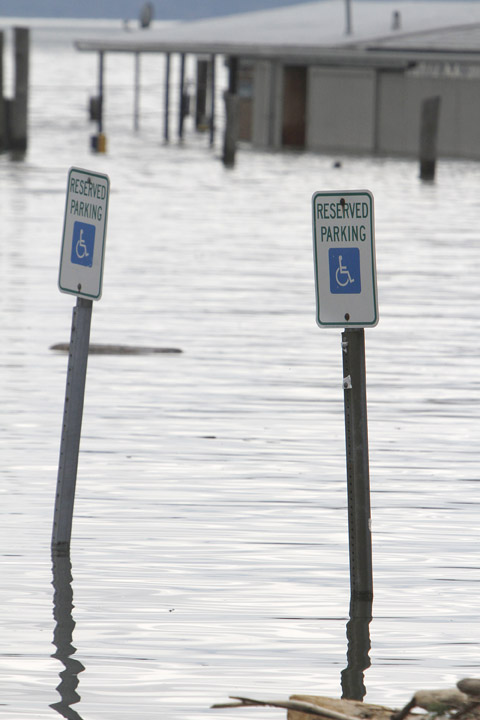MONTPELIER, Vt. — Already at its highest level ever, Lake Champlain surpassed flood stage by 3 feet today, leaving hundreds of homes destroyed or damaged in a slowly unfolding catastrophe on island communities and the New York and Vermont sides of the 120-mile-long lake.
Teams from the Federal Emergency Management Agency will be in Vermont on Tuesday to begin assessing damage, said spokesman Dennis Pinkham. Authorities said it could be weeks before floodwaters, which took weeks to hit current levels, recede.
“I had a guy from the state tell me that this was the slowest disaster he’s ever seen,” Clinton County Emergency Services Director Eric Day told the Press-Republican newspaper of Plattsburgh, N.Y., where about 100 residents of an apartment complex evacuated today.
The two major east-west roads that link the Vermont island county of Grand Isle to the mainland remained open but were water-covered, according to Gov. Peter Shumlin, who wouldn’t rule out mandatory evacuations but said they aren’t necessary yet.
Shumlin toured the flooded area by helicopter this week and then declared the area a disaster, which allowed him to call up help from the Vermont National Guard.
Soldiers have filled about 67,000 sandbags and provided high-water vehicles to help with recovery efforts.
Maj. Gen. Michael Dubie, commander of the Vermont National Guard, said that 136 soldiers are available on four hours’ notice if need be, and that another 350 could be made available on 24 hours’ notice if the state requests it.
Four to eight FEMA representatives, joined by Vermont Emergency Management officials, will tour the hardest-hit areas to do a preliminary assessment, Shumlin said.
Typically, spring rains and snowmelt in Vermont pose a threat for river flooding. This year, it’s the lake, fed by rivers and tributaries in the Adirondacks of New York state and the Green Mountains of Vermont.
The lake, which separates upstate New York from Vermont and stretches into Canada, reached its highest level ever last week and has continued to rise.
At 2 p.m. today, the level of the water at Burlington, Vermont’s largest city, was 103.22 feet above sea level, down from 103.26 at 12:30 p.m. Flood stage is 100 feet.
The state Health Department warned those in flood-stricken areas who use water from private wells to boil it before consuming. Anyone whose well was affected by flooding should bring their water to a rolling boil for one minute, or to use bottled water, or water from a known, safe source, they said.
The precautions were recommended until flood waters ebb, the well has been disinfected, the bleach odor has worn off and a follow-up bacterial test find it safe.
In Burlington, a city of 39,000 people where about 50 homes have been flooded, city officials announced the formation of a volunteer effort to help victims, coinciding with the state’s annual Green Up Day on Saturday.
Volunteers will gather at Leddy Park to fill sandbags that will be given to people in flooded neighborhoods.
Lake Champlain empties into the Richelieu River, which flows northward through Quebec and flooded fields and homes along its length.
The National Weather Service said today it was optimistic that the lake level would peak within 48 hours and begin to recede next week. But it won’t happen quickly.
“Historically, when we see it go up above flood stage, it usually takes 20 days per foot of drop,” said Greg Hanson, a National Weather Service hydrologist in South Burlington. “So now, we’re at 103 feet (above sea level), which would be 60 days. If we don’t get any rain, we can fall faster than that. If we get some rain, it’ll certainly be slower.”
“It takes a long time for it to go back.”
Send questions/comments to the editors.



Success. Please wait for the page to reload. If the page does not reload within 5 seconds, please refresh the page.
Enter your email and password to access comments.
Hi, to comment on stories you must . This profile is in addition to your subscription and website login.
Already have a commenting profile? .
Invalid username/password.
Please check your email to confirm and complete your registration.
Only subscribers are eligible to post comments. Please subscribe or login first for digital access. Here’s why.
Use the form below to reset your password. When you've submitted your account email, we will send an email with a reset code.